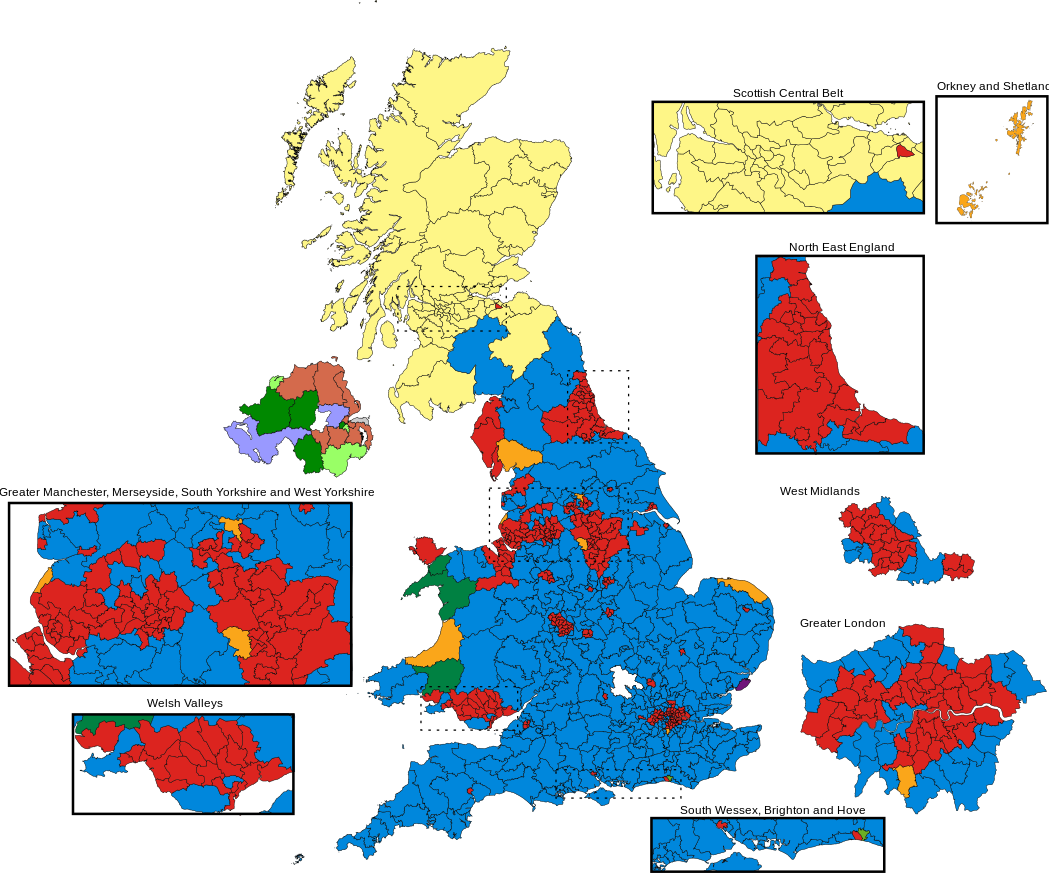Plaid Cymru had an election to forget on 7 May 2015. They marginally improved their vote share across Wales, but found themselves overtaken by UKIP on that measure, with the Lib Dem collapse largely bypassing them. Their seat tally was unchanged, missing out on Ynys Mon by a whisker and failing by a larger margin to wrest Ceredigion out of Lib Dem hands. Indeed, in their top ten targets, they lost vote share in all bar three constituencies: Ynys Mon, Rhondda and Cardiff West.
Considering that Plaid Cymru had more election coverage than ever before and featured in the national televised debates, this failure to make any significant advance must be seen as a serious disappointment. The contrast with the triumph of their fellow nationalists in Scotland in the same election could not be starker.
Plaid Cymru's prospects
What are Plaid Cymru's prospects for 2020? Well, first of all it must be noted that there are likely to be boundary changes, so these lists should not be taken as precise seat targets but as a general indication of where Plaid Cymru may prosper or flounder. This is particularly important in Wales where any boundary changes are likely to be particularly far-reaching, given the current over-representation in Parliament that Wales enjoys. A reduction in seat counts is usually more harmful for smaller parties but in the case of Plaid Cymru that may not in fact be the case because its vote is concentrated geographically, being particularly strong in north west Wales. (It would, however, make UKIP's chances of taking a seat in Wales harder - their support is very evenly spread, not exceeding 20% in any existing constituency.)
Here are the Welsh constituencies organised by diminishing Plaid Cymru vote share:
https://docs.google.com/spreadsheets/d/14JKN65Dy5C3N1vqEEkX_0BSk73v0xExcIFRRiapByzo/edit?usp=sharing
This table was prepared by AndyJS.
Alternatively, here are the Welsh constituencies organised by the swings that Plaid Cymru would require to take each seat:
https://drive.google.com/file/d/0Bygi8eZw-4q1by0wMmNnUVVCZFU/view?usp=sharing
As you can see, Plaid Cymru's prospects differ considerably between the two lists given above. Which is more useful?
To determine the answer, we first need to look at a different election in a different part of the UK.
The Scottish great leap forward
In 2010, the SNP made only modest progress in vote share and won no new Westminster seats. This was their target list in the run-up to this year's election, arranged by swing:
https://docs.google.com/document/d/1WBE7ZiFBcNn8pKRZwwImmfi6eqm3jMKI3Jo_k2m-nEQ/edit?usp=sharing
The SNP required some pretty heroic swings, and by and large it got them. There does not seem to have been a particularly strong relationship between the seats which it did not win and the swings required to take them. Edinburgh South and Dumfriesshire, Clydesdale & Tweeddale would require relatively small swings to the SNP while Orkney & Shetland would have required the second largest swing.
However, there is a strong correlation between SNP performance in 2015 and its absolute vote share in 2010, at least at the bottom end of that table. The ten lowest SNP vote shares in 2010 were (from the bottom up):
Edinburgh South
East Renfrewshire
Berwickshire, Roxburgh & Selkirk
Edinburgh North & Leith
East Dunbartonshire
Dunfermline & West Fife
Orkney & Shetland
Dumfriesshire, Clydesdale & Tweeddale
Aberdeen South
Glasgow North
This list includes all three of the seats that the SNP did not take in 2015 and four of the five most marginal SNP seats for 2020. It seems that if the mould is broken by a party that soars in the polls, prior vote share is a more reliable guide than swing required as to where the mould will break least.
Revenons a nos moutons
That is all well and good, but Plaid Cymru in 2015 are far behind where the SNP were in 2010. Their vote share in 2015 across Wales is only just over half what the SNP had across Scotland in 2010. The SNP was second in vote share in Scotland in 2010 while Plaid Cymru remains fourth in vote share in Wales in 2015. The SNP was in power in Holyrood and was able to engineer a lengthy and all-consuming debate about national identity between 2010 and 2015. Plaid Cymru is in opposition in the Welsh Assembly and there is no particular reason to expect that to change next year. Mould-breaking (and Mold-taking) looks like a distant prospect.
I would pretty much completely discount the chances of Plaid Cymru in any seat where they had not already got at least 15%, even allowing for the fact that the four or five party nature of Welsh politics means that seats can be taken on relatively low vote shares. On current boundaries, that means that they have a vague interest in just nine seats. A uniform 5% swing to Plaid Cymru would deliver them just two extra seats on these boundaries. A uniform 10% swing to Plaid Cymru would deliver them just one more.
But if Plaid Cymru are to make any progress at all, they need to start gaining vote share. They can't profit by being bystanders while other parties rise and fall. They need to look at what the SNP has achieved in Scotland, consider how that may be applied to their circumstances in Wales and act accordingly. Otherwise, they could be waiting for the great leap forward for a very long time indeed.
Plaid Cymru's prospects
What are Plaid Cymru's prospects for 2020? Well, first of all it must be noted that there are likely to be boundary changes, so these lists should not be taken as precise seat targets but as a general indication of where Plaid Cymru may prosper or flounder. This is particularly important in Wales where any boundary changes are likely to be particularly far-reaching, given the current over-representation in Parliament that Wales enjoys. A reduction in seat counts is usually more harmful for smaller parties but in the case of Plaid Cymru that may not in fact be the case because its vote is concentrated geographically, being particularly strong in north west Wales. (It would, however, make UKIP's chances of taking a seat in Wales harder - their support is very evenly spread, not exceeding 20% in any existing constituency.)
Here are the Welsh constituencies organised by diminishing Plaid Cymru vote share:
https://docs.google.com/spreadsheets/d/14JKN65Dy5C3N1vqEEkX_0BSk73v0xExcIFRRiapByzo/edit?usp=sharing
This table was prepared by AndyJS.
Alternatively, here are the Welsh constituencies organised by the swings that Plaid Cymru would require to take each seat:
https://drive.google.com/file/d/0Bygi8eZw-4q1by0wMmNnUVVCZFU/view?usp=sharing
As you can see, Plaid Cymru's prospects differ considerably between the two lists given above. Which is more useful?
To determine the answer, we first need to look at a different election in a different part of the UK.
The Scottish great leap forward
In 2010, the SNP made only modest progress in vote share and won no new Westminster seats. This was their target list in the run-up to this year's election, arranged by swing:
https://docs.google.com/document/d/1WBE7ZiFBcNn8pKRZwwImmfi6eqm3jMKI3Jo_k2m-nEQ/edit?usp=sharing
The SNP required some pretty heroic swings, and by and large it got them. There does not seem to have been a particularly strong relationship between the seats which it did not win and the swings required to take them. Edinburgh South and Dumfriesshire, Clydesdale & Tweeddale would require relatively small swings to the SNP while Orkney & Shetland would have required the second largest swing.
However, there is a strong correlation between SNP performance in 2015 and its absolute vote share in 2010, at least at the bottom end of that table. The ten lowest SNP vote shares in 2010 were (from the bottom up):
Edinburgh South
East Renfrewshire
Berwickshire, Roxburgh & Selkirk
Edinburgh North & Leith
East Dunbartonshire
Dunfermline & West Fife
Orkney & Shetland
Dumfriesshire, Clydesdale & Tweeddale
Aberdeen South
Glasgow North
This list includes all three of the seats that the SNP did not take in 2015 and four of the five most marginal SNP seats for 2020. It seems that if the mould is broken by a party that soars in the polls, prior vote share is a more reliable guide than swing required as to where the mould will break least.
Revenons a nos moutons
That is all well and good, but Plaid Cymru in 2015 are far behind where the SNP were in 2010. Their vote share in 2015 across Wales is only just over half what the SNP had across Scotland in 2010. The SNP was second in vote share in Scotland in 2010 while Plaid Cymru remains fourth in vote share in Wales in 2015. The SNP was in power in Holyrood and was able to engineer a lengthy and all-consuming debate about national identity between 2010 and 2015. Plaid Cymru is in opposition in the Welsh Assembly and there is no particular reason to expect that to change next year. Mould-breaking (and Mold-taking) looks like a distant prospect.
I would pretty much completely discount the chances of Plaid Cymru in any seat where they had not already got at least 15%, even allowing for the fact that the four or five party nature of Welsh politics means that seats can be taken on relatively low vote shares. On current boundaries, that means that they have a vague interest in just nine seats. A uniform 5% swing to Plaid Cymru would deliver them just two extra seats on these boundaries. A uniform 10% swing to Plaid Cymru would deliver them just one more.
But if Plaid Cymru are to make any progress at all, they need to start gaining vote share. They can't profit by being bystanders while other parties rise and fall. They need to look at what the SNP has achieved in Scotland, consider how that may be applied to their circumstances in Wales and act accordingly. Otherwise, they could be waiting for the great leap forward for a very long time indeed.





